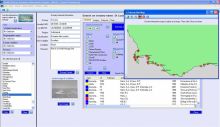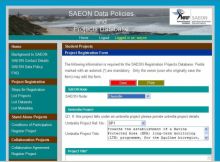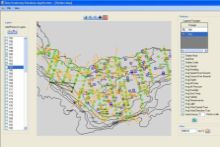Committee aims to establish SAEON’s Information Pillar as a national asset
|
The SAEON Information Management Steering Committee (SIMSC) was recently formed to drive the Information Pillar of the official SAEON mandate.
The Committee’s focus is to develop SAEON’s internal information management systems, but working in synergy with external systems and especially with the SAEON data portal (SDP).
One major objective of SIMSC will be to publish scientific, information and education products from the knowledge contained within datasets available to SAEON. The end result will include products such as databases, web sites, standalone applications, system interfaces and interoperable services (to name a few), as well as articles for popular publications and papers for scientific journals.
The scope of the products will be cross-disciplinary and inter-nodal in order to gain a holistic view of environmental change in South Africa. These products are likely to grow from initiatives originating at a node, which are initially aimed at addressing issues important to that node but are recognised as having a wider application.
The SIMSC inaugural meeting, which was held in May 2010, was attended by SAEON’s Data Portal Manager (Wim Hugo), Egagasini (Wayne Goschen) and Fynbos (Victoria Goodall) node Data Managers, SAEON’s Information Management Scientist (Gavin Fleming) and a Marine Data Specialist (Fiona Cuff). Unfortunately node representatives from SAEON’s Ndlovu and Elwandle nodes could not make this meeting, but all the SAEON nodes are represented on the committee.
The rationale for SIMSC derives from the strategic statements of SAEON:
- Vision: "A comprehensive, sustained, coordinated and responsive South African environmental observation network that delivers long-term reliable data for scientific research and informs decision-making; for a knowledgeable society and improved quality of life"
- Mantra: "Observation, Information, Education"
- Mission: "To detect, predict and react to environmental change in South Africa"
- Currency: "Long-term data on environmental change"
The above statements imply that an integrated information management system is a key element of SAEON. Originally this was implemented as an extension of the SA-ISIS project, specially built to fulfil the objectives of SAEON, and which would allow SAEON nodes to exchange data.
Specialist focus groups
In the initial years of SAEON’s development, a Technical Steering Committee made up of stakeholder representatives acted as the oversight mechanism on all matters related to science and information management. This committee was eventually disbanded in 2009 in order to create space for more specialist focus groups.
Rapid growth in all its departments has been a feature of the first eight years of SAEON’s existence. Although never envisaged originally, SAEON employed a Systems Engineer (Wim Hugo) to continue the development of the information backbone. This backbone has been subsequently developed into a major national asset with the flexibility to be re-used for various purposes. A major component of this system is the SAEON data portal (SDP). Wim has taken development on the SDP to a stage where a planned live release is imminent.
Focus has now switched from the development of the main data portal to the development of data, scientific and information products. Since the responsibility for data management is a key function of SAEON’s nodes, the nodes will play a major role in this initiative.
To support the vision of SAEON, the need for a concerted effort on data management across the nodes was recognised early on. This has led to several ad hoc meetings and joint inter-nodal projects over the years. Thus SIMSC was formed in order to constitute a cohesive body for all aspects of information management across SAEON.
Projects that SIMSC members are currently working on include:
- South African Estuaries Information System: database, standalone application and web site
- SAEON Data Policy and Project Documentation: database and web site
- Ships Underway System: database, standalone application and web site
- South African Estuaries Management Plans: database and web-site
- Jonkershoek Data: database by Victoria Goodall
- Cape Point Vegetation: development in progress
- Nitrogen Deposition: development in progress
- Nairobi Convention Clearing House (NCCH): GeoNetwork/ Geoserver site
- Algoa Bay Long-term Monitoring and Research: data management
- SAEON Data Management Framework: a framework document
- SADCO Popular Products: an informative web site on oceanography for the Southern African Data Centre for Oceanography (SADCO)
- SADCO Interoperable Services: exposing SADCO’s metadata (and possibly data) to the wider community.
- Algoa Bay Marine Environment: database and web site
- MCM data management: facilitating data management in Marine and Coastal Management (MCM)
- OceanSAfrica: an Operational Oceanography (OO) initiative
- Centre for Operation Oceanography (CFOO): assisting in the development of a web site displaying live data
- Guidelines for common ontologies and vocabularies
- Fire data for the Fynbos Node
- Harvester for Metacat and GeoNetwork














